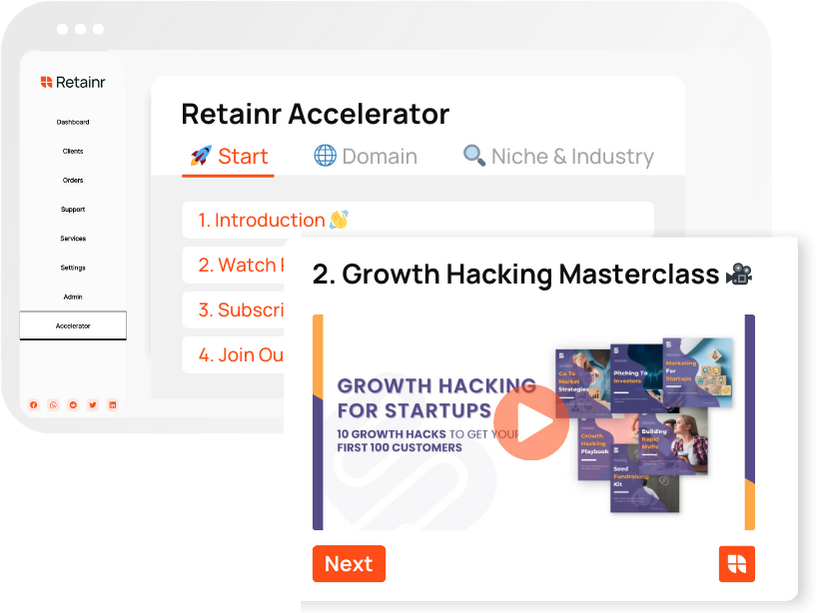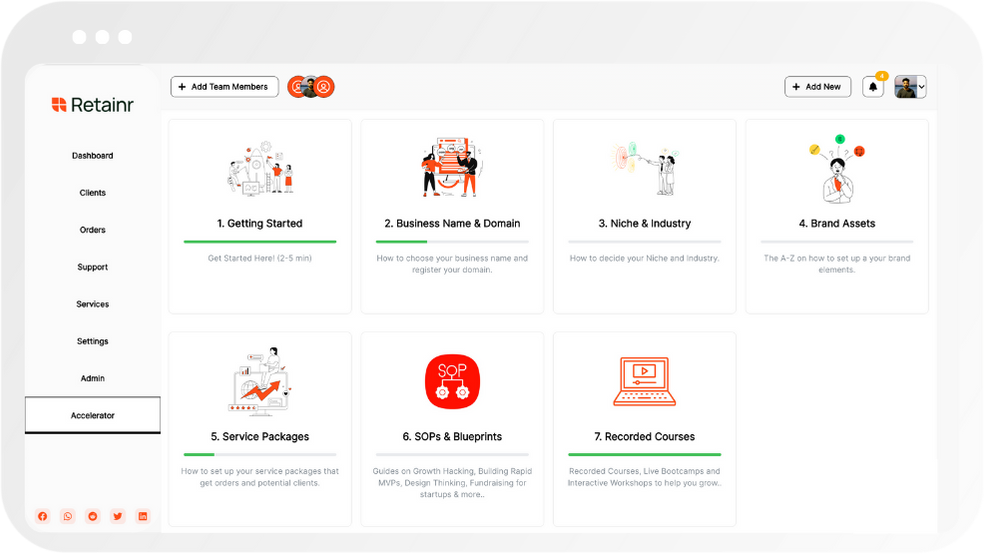
10 Ways to Stay Ahead in a Rapidly Changing Business Environment
Build with Retainr
Sell your products and services, manage clients, orders, payments, automate your client onboarding and management with your own branded web application.
Get Started1. What are the top 10 ways to stay ahead in a rapidly changing business environment?
Understanding Current and Future Business Trends
Staying informed about current and future business trends is crucial in a fast-paced business environment. It entails researching what's trending in your industry, identifying key business trends through forecasting, and keeping track of potential disruptive technology. Furthermore, engaging in constant learning, enrolling in training programs, and attending industry-specific conferences can offer you the edge over competitors.
Investing in Technology
Embrace technology, which is often the driving force behind business changes. Incorporate technological advancements in your day-to-day operations. It spans from the use of data analytics to guide decision making, automation for repetitive tasks, to online platforms for marketing and communication. Notably, businesses that leverage technology register improved efficiency, enhanced communication, accurate predictions, and ultimately, grow.
Adapting to Change
Being adaptable is pivotal in ensuring the survival of any business. It involves remaining flexible, embracing change positively, and being ready to evolve when necessary. The importance of adaptability can't be overstated, as it equips your business to respond appropriately when things change unexpectedly. Moreover, it helps in maintaining competitiveness by adjusting swiftly to new market trends.
| Strategy | Description |
|---|---|
| Collaboration | Working together with both internal teams and external bodies to foster innovation and efficiency. |
| Customer Focus | Prioritizing customer needs and feedback to drive overall business growth and sustainability. |
| Risk Management | Identifying, assessing and controlling threats to an organization's capital and earnings. |
| Emphasizing Agility | Developing business models and structures that allow for quick and responsive adaptation to changes in the environment. |
| Continuous Learning and Innovation | Constant improvement through the harnessing of new ideas and processes. |
2. How can investing in employee growth help a business adapt to a changing environment?
Investing in Employee Growth for Business Adaptability
Investments in employee growth are key strategies for businesses to adapt to dynamic environments. These investments can take different forms, including professional training, mentorship programs, and skill development initiatives. Such investments benefit the business in several ways:
- Improved skills and competencies: Continued learning programs help employees develop new skills or improve existing ones, thus, enabling them to perform better in their roles.
- Boosted morale and retention: When employees see that a company is willing to invest in their growth, they become more engaged and are likely to stay with the company for a longer period.
- Innovative thinking: Nurturing employee growth often means fostering a culture of innovation and creativity. This can be especially beneficial in changing business environments, where fresh ideas and problem-solving skills are in high demand.
Employee Growth Investment: Key Metrics
Prioritizing employee growth is not just a philosophy, but it should be tied to measurable outcomes. Here are three important metrics that can help a business evaluate the impact of its investment in employee growth.
| Key Metric | Description |
|---|---|
| Employee Turnover Rate | This measures the number of employees leaving the company. A decrease in turnover rate typically indicates successful employee growth initiatives. |
| Employee Engagement Score | This measure shows the level of employee job satisfaction and engagement. Higher scores are usually linked to effective growth and development programs. |
| Productivity Metrics | These vary by job role but are generally aimed at evaluating the effectiveness and efficiency of an employee's work. Increase in productivity can often be directly linked to successful training and development initiatives. |
3. How does understanding and predicting industry trends contribute to business success in a rapidly changing environment?
Understanding Industry Trends
Understanding industry trends is a critical factor for staying ahead in a dynamic business environment. This knowledge enables businesses to identify new opportunities, mitigate risks, and make informed decisions. For example, if a business is aware that demand for cloud-based services is growing, it can strategically invest in this sector to capitalize on this trend. Likewise, understanding that a specific product is falling out of favor can help companies pivot and avoid significant losses.
- Predict shifts in customer preferences
- Identify emerging markets and segments
- Plan for potential industry disruptions
Predicting Industry Trends
Predicting industry trends, though complex, can provide a significant competitive advantage. It involves analyzing historical data, staying updated on industry news, and considering broader economic factors. A company that can anticipate changes will be better prepared to adapt its strategies accordingly. A business could forecast the rise in remote work culture and invest in developing collaborative tools, thus benefiting from the increased demand. Effective trend prediction can:
- Enable proactive strategic planning
- Facilitate faster response to market changes
- Help capitalize on new opportunities
Industry Trends and Business Success
| Understanding Trends | Predicting Trends |
|---|---|
| Allows businesses to stay relevant by meeting changing customer needs | Provides early warning of potential threats and opportunities |
| Helps businesses make informed investment decisions | Enables firms to gain first-mover advantage |
| Enables risk mitigation through strategic planning | Facilitates budgeting and sales forecasting |
In conclusion, understanding and predicting industry trends can significantly boost a business's resilience and adaptability in a rapidly changing environment, ultimately leading to its growth and success.
4. Can active listening to customer feedback drastically improve my business adaptability?
Understanding the Importance of Active Listening to Customer Feedback
Active listening to customer feedback is a crucial strategy for staying ahead in the rapidly changing business environment. Customers are the lifeblood of any business, and their opinions and experiences can provide invaluable insights into the current market trends, their developing needs, and areas of your business that require improvement. By proactively gathering and incorporating this feedback into your business strategy, you increase your business adaptability by ensuring that your decisions are not set in stone, but rather, responsive to change. This strategy helps you maintain relevancy in your chosen industry and keeps you attuned to your customers' changing needs.
Ways Active Listening to Customer Feedback Enhances Business Adaptability
Listening to customer feedback allows you to adapt your products, services, and processes to better align with your customers' needs and expectations. Some ways incorporating feedback improves business adaptability are:
- Improved Products and Services: Feedback allows you to fine-tune your offerings to better meet customer needs. This ensures your business continues to stay relevant despite changing customer preferences and market demands.
- Enhanced Customer Experience: Proactive interpretation of feedback can result in enhanced customer experience, helping to build strong customer relationships and loyalty.
- Informed Decision Making: Decisions backed by real-time customer feedback are more strategic and future-oriented and less speculative.
Key Metrics to Track Customer Feedback
Key performance indicators (KPIs) can provide a quantifiable measure of how well you're listening and responding to customer feedback. Consider tracking the following metrics:
| Key metric | Description |
|---|---|
| Net Promoter Score (NPS) | Measures whether your customers would recommend you to others |
| Customer Satisfaction Score (CSAT) | Evaluates customer satisfaction with a particular product, service or interaction |
| Customer Effort Score (CES) | Assesses how easy it is for customers to do business with you |
5. How does fostering a culture of innovation help my business stay ahead of changes?
Understanding Innovation Culture
Innovation culture is a work environment that encourages and cultivates creative thinking, fostering new discoveries and ideas. This culture is essential for any business in the dynamic marketplace as it fosters creativity, critical examination, and exploration of new possibilities. The importance of an innovation culture in business can be divided into three main aspects:
- It ignites creativity: Innovation culture encourages employees to think outside the box. This leads to the development of unique and diverse ideas which can give the company a competitive edge.
- It supports adaptation: An innovative environment allows businesses to adapt to changes quickly, aligning with the trends in the market. This helps in staying ahead and relevant in the rapidly changing business environment.
- It drives growth: Promoting innovation culture means fostering new ideas which can transform into products, strategies, or processes that drive growth and profitability.
How to Foster Innovation Culture
Creating an innovation culture demands strategic effort. It's not just about encouraging creativity but also giving employees freedom, fostering their talents, and promoting a positive work environment. Here are five steps to instil it:
| Steps | Explanation |
|---|---|
| Encourage creativity and risk-taking | Create an environment in which unique ideas and calculated risks are celebrated instead of punished. |
| Create diverse teams | Diverse teams bring different perspectives, encouraging a wide range of ideas. |
| Invest in Training | Equip workers with the skillset to think critically and solve complex problems creatively. |
| Promote open communication | Fostering a culture of open communication eliminates barriers and allows free exchange of ideas. |
| Reward Innovations | Offer incentives or rewards for creative ideas or innovations to motivate employees to think creatively. |
Impact of Innovation Culture on Business
Adopting a culture of innovation significantly impacts a business's evolution and growth. It brings about three main advantages:
- Stay Competitive: Innovation culture enables businesses to stay agile and respond quickly to market changes or industry advancements, enhancing competitiveness.
- Improved Product/Service: Consistent innovation can lead to better product/service development, enhancing the customer experience and satisfaction levels.
- Increased Market Share: Businesses that constantly innovate can capture a larger market share due to their uniqueness and ability to stay relevant to the customers.
Thus, fostering innovation culture is crucial for businesses to stay ahead in today's rapidly changing environment.
6. How does adapting to new technology help enhance business operations in a rapidly evolving market?
Adapting New Technology to Enhance Business Operations
The world has become heavily dependent on technology, and businesses are no exception. With a rapidly changing business environment, the adoption of new technology is key to staying competitive. Here's how:
1. Efficiency and Productivity
Technology automates manual tasks, reducing the possibility of errors and increasing output. This allows businesses to operate more efficiently and productively. Take for example, transitioning from a manual to an automated payroll system. The time saved can be reinvested into other parts of the business, making it even more efficient.
| Manual Task | Automated Task |
|---|---|
| Payroll calculation | Automated payroll system |
| Project tracking | Project management software |
2. Improved Communication and Collaboration
Technology like conferencing tools and collaborative workplace platforms have transformed the way teams communicate and function. This helps to strengthen inter-departmental cooperation and ensures everyone is working with up-to-date information.
- Zoom for virtual meetings
- Slack or Microsoft Teams for real-time collaboration
- Trello or Asana for task management
3. Advanced Customer Service
Modern consumers expect high levels of service and instant gratification. Technology allows businesses to meet these expectations through real-time customer service tools such as chatbots and social media. This not only satisfies customers but gives businesses valuable insights into customer behavior and preferences.
| Old Method | New Technology |
|---|---|
| Email or Phone | Real-time chatbots |
| Generic Ads | Personalized Ads based on behavior |
7. Can a proactive and forward-thinking approach towards business strategy help to stay ahead in a changing business environment?
Proactive and Forward-Thinking Approach
In a rapidly changing business environment, having a forward-thinking and proactive approach to business strategy is not an option—it’s a necessity. The business world today demands swift decision-making and proactive strategies to stay ahead of the curve. By being reactive, businesses put themselves in a position of always playing catch up. Here are some ways in which proactive approach can assist:
- Proactive problem solving: Addressing potential issues before they become major problems can save businesses time and resources.
- Stay current and competitive: By constantly monitoring market trends and evolving appropriately, businesses can maintain a competitive edge.
- Better Planning: Forward-thinking allows businesses to plan for the future and to be prepared for any potential changes.
Applying a Proactive Approach
Knowing that a proactive approach is beneficial is one thing—actually applying it can be a different challenge altogether. However, there are several key steps that businesses can take:
- Collaborate: Building a culture of collaboration encourages collective problem-solving and idea generation.
- Invest in Technology: Leveraging the right technology can help in automating certain processes, thus giving more time to focus on strategic work.
- Employee Development: Regular training and skill development of employees are paramount to stay agile and readily accept change.
A Comparative Insight
To visualize the difference between a reactive and proactive business strategy, consider the table below:
| Reactive Approach | Proactive Approach |
|---|---|
| Deals with problems after they occur | Prevents problems before they occur |
| Focuses on immediate concerns | Plans and prepares for future |
| May not adjust well to change | Embraces change and uses it to advantage |
8. How can businesses effectively utilize analytics and data to make informed decisions?
Understanding Analytics & Data
The world of business is increasingly being driven by analytics and data. By collecting and analyzing data, organizations can gain insights into customer behavior, market trends, operational efficiency, and many other areas. In turn, these insights can inform strategy and decision-making processes. Businesses can also use analytics to monitor their performance, identify areas for improvement, and forecast future trends.
- Collecting analytics: Tools like Google Analytics can track website visits, user engagement, conversion rates, and other valuable information.
- Using data: Companies can use this data to understand customer preferences, optimize marketing strategies, improve product or service quality, and make other informed decisions.
Transforming Data into Actionable Insights
Data and analytics are useful only when they are translated into actionable insights. This requires having the right technologies, processes and skills in place. Predictive analytics, for example, uses historical data to forecast future scenarios. Descriptive analytics, on the other hand, helps to understand past performance. While prescriptive analytics offers recommendations based on data analysis.
| Type of Analytics | Description |
|---|---|
| Predictive Analytics | Uses historical data to forecast future scenarios |
| Descriptive Analytics | Helps to understand past performance |
| Prescriptive Analytics | Offers recommendations based on data analysis |
Building a Data-Driven Culture
Utilizing analytics and data effectively requires a company-wide, data-driven culture. Data should be at the center of strategic decision-making. This means making data available and accessible to employees, providing training in data analysis, and rewarding data-driven decision making.
- Availability of data: Employees should have access to relevant, reliable and timely data.
- Training: Businesses should foster a learning environment where employees are trained and supported in data analytics.
- Rewarding data-driven decisions: Leading with data must become a part of the company culture, and should be recognized and rewarded.
9. What role does strategic partnerships play in enhancing a business's adaptability in a rapidly changing environment?
Strategic Partnerships and Business Adaptability
In an ever-evolving business environment, strategic partnerships can be the key to increase adaptability. One of the significant benefits of strategic partnerships is the sharing of resources and capabilities, which can ultimately lead to business growth and adaptability in a rapidly changing environment.
- Resource sharing: Businesses can mutually benefit by sharing resources such as expertise, technology, and physical resources. This collaboration can often lead to innovation and advancement, allowing businesses to stay ahead in a competitive environment.
- Operational efficiencies: By streamlining efforts and reducing duplicative work, strategic partnerships can increase operational efficiencies. This efficiency can free up resources for other initiatives to adapt to changing market conditions.
Additionally, strategic partnerships open up new markets and networking opportunities which can lead to increased business opportunities. This collaboration also allows for a greater pool of expertise, skills and contacts.
| New market access | Networking opportunities |
|---|---|
| Strategic partnerships can provide businesses with access to new markets that would otherwise be hard to break into. This allows businesses to diversify their customer base and reduce risk. | Partnerships also allow businesses to connect with potential new partners, suppliers and customers, extending their reach and presence in the business world. |
Lastly, forming strategic partnerships can also lead to enhanced credibility. A partnership with a well-established, respected organization can increase consumer trust in your business. This enhanced credibility can be especially important when pioneering innovative products or services. Thus, strategic partnerships can play a vital role in enhancing a business's adaptability in a rapidly changing environment.
10. How essential is it to stay flexible and adaptable in business operations in a rapidly changing business environment?
The Importance of Flexibility and Adaptability in Business Operations
As the business landscape continues to evolve, the ability to stay flexible and adaptable has never been more essential. These attributes enable businesses to quickly adjust their strategies, processes, and operations in response to changes in the market or competitive environment. They also enhance a company's resilience, innovation, and competitiveness, thus giving it a competitive edge.
Though implementing flexibility and adaptability in business operations can be challenging, several strategies can be employed:
- Encourage a Culture of Innovation: Promote new ideas within your organization by welcoming suggestions and promoting an innovative culture.
- Invest in Employee Training: Provide regular training to your employees so they can adapt to rapidly evolving business environments.
- Implement Agile Methodologies: Using agile methodologies can help the business adjust to changes more quickly and effectively.
- Leverage Technology: Technological tools can optimize operations, enhance communication, improve customer service, and streamline processes.
- Continuously Update Business Strategies: Review your business strategies regularly and adjust them as per market trends and customer needs.
Tracking Business Flexibility and Adaptability
It’s equally important to measure the effectiveness of your adaptability and flexibility strategies. Key indicators can help determine if your business operations are flexible and adaptable in response to a changing business environment. Using a table format, you can track your progress:
| Indicator | Description |
|---|---|
| Change Management Efficiency | This measures how quickly and efficiently your business implements changes. |
| Innovation Rate | This reflects the number of new ideas or strategies implemented to stay competitive in the market. |
| Employee Skills Adaptability | This assesses how well your employees are adapting to new technologies or methodologies. |
| Customer Satisfaction Level | This represents how well your changes have been received by your customers. |
Conclusion
Stay Ahead in a Rapidly Changing Business Environment
In today's fast-paced world, businesses need to constantly adapt and innovate to stay competitive. Here are ten ways to stay ahead in such an environment:
- Continual Learning: Continuously upgrade your skills and knowledge about your industry.
- Innovation: Embrace new ideas and technologies to differentiate your business from the competition.
- Agility: Equip your business to adapt to changes quickly.
- Listen: Pay attention to your customers’ needs and adapt your products or services accordingly.
- Network: Establishing relationships with other businesses can open up new opportunities.
- Technology Advancement: Incorporate new technologies to streamline processes and increase productivity.
- Embrace Flexibility: Remain open to new ways of doing business.
- Focus on Your Customer: Customer satisfaction should be your primary goal.
- Plan: Have a clear strategy to drive your business forward.
- Use Efficient Tools: Invest in tools like Retainr.io that can streamline your daily operations, manage clients, orders and payments with a customized branded app.
Manage Your Business Seamically with Retainr.io
Keeping pace with the progressive business environment requires the right set of tools and that's where Retainr.io steps in. With a focus on selling, client management, order handling, and payments, Retainr.io is a feature-packed software platform that allows your business to have its own branded app. More than a software, it is a complete business companion equipped with features capable of assisting on each step to success. With Retainr.io, business management gets simplified, helping you to focus more on growing your business than managing it.
For more information, visit www.retainr.io and give your business the cutting edge it needs.
Boost Your Agency Growth
with Retainr Accelerator
Uncover secrets, strategies, and exclusive blueprints to take your agency's growth to the next level — from marketing insights to effective presentations and leveraging technology.

SOPs, Cheatsheets & Blueprints
Leverage 50+ SOPs (valued over $10K) offering practical guides, scripts, tools, hacks, templates, and cheat sheets to fast-track your startup's growth.
Connect with fellow entrepreneurs, share experiences, and get expert insights within our exclusive Facebook community.
.jpg)

Join a thriving community of growth hackers. Network, collaborate, and learn from like-minded entrepreneurs on a lifelong journey to success.

Gain expertise with recorded Courses, Live Bootcamps and interactive Workshops on topics like growth hacking, copywriting, no-code funnel building, performance marketing and more, taught by seasoned coaches & industry experts.

.jpg)

.jpeg)


